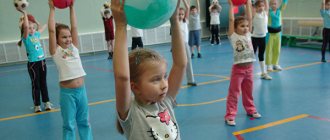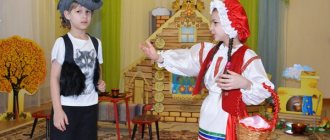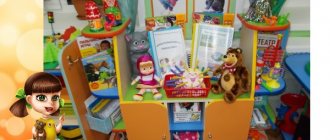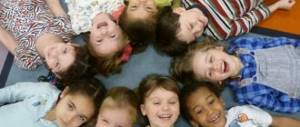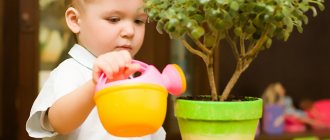MAGAZINE Preschooler.RF
Calendar plan for the week “Friendship. National Unity Day"Monday Date: 26.10.2020 – 30.10.2020
Goal: To expand students’ understanding of their native country and public holidays; arouse interest in the history of your country; cultivate a sense of pride in one’s country and love for it. Introduce the history of Russia, the coat of arms, the flag and the melody of the anthem.
Final event: “Friendship is our strength .
Joint activity of the teacher with the pupils Independent activity of the pupils Individual work of the teacher with the pupils
Morning
Conversation “National Unity Day” Expand the students’ understanding of the national holiday, talk about the history of its origin, the meaning of this holiday for people.
Working in a corner of nature: “Learning to maintain order” The ability to use rational work methods to maintain cleanliness in a corner of nature.
D/i according to FEMP: “Mathematical Lotto” - the ability of students to make signs. On speech development: exercise “Say it correctly” Exercise Roma, Egor S., Egor P. in the selection of antonyms and synonyms for adjectives and verbs, the ability to coordinate words in sentences.
Program content, methodological techniques
GCD
Musical development: according to the plan of the music director. See Attachment. Lesson No. 7.
GCD
Cognitive development (social world): Topic: “What peoples live in Russia . Literature: page 47 N.G. Zelenova, L.E. Osipova
Program content: To introduce students to the multinational composition of the Russian population. Cultivate respectful, friendly feelings towards people of different nationalities. Methods: conversation, questions and answers, examination of illustrations of the peoples of Russia, their folk costumes, physical education, conversation, summing up the GCD. Means: illustrations depicting people in national costumes, dishes of national cuisine of different nations, illustrations or folk crafts, a globe.
GCD
Speech development: (reading fiction). Topic: Reading the poem “Russian Family” . Literature: printout. Program content: expand children's ideas about the territory of Russia and the peoples inhabiting it;
To cultivate respect for the various nationalities of Russia, their culture, language; To promote the development of the ability to perceive the figurative content of a work; comprehend the characters, the idea; consolidate knowledge about the genre features of the work (fairy tale, story, poem); form imagery of speech. Methods: conversation about Russia, about the peoples inhabiting it; viewing the world map, Russia; reading a poem, talking about what you read, looking at dolls from the “National Costumes” ; learning proverbs about friendship. summing up the educational activities directly. Tools: world map, Russia, dolls from the “National Costumes” , multimedia equipment (projector, screen). a book with a poem.
Walk
Observing the weather - consolidating the students’ ability to identify and reflect in speech the state of the weather, characterize changes that have occurred over a certain period of time, and mark them in the weather calendar. The outdoor game “Fox and Hares” - to form ideas about the lifestyle and habits of animals;
Work “Let's put away the toys together!” develop behavior and positive relationships between children; ability to work together.
S/r game - to develop the ability to unite in the game, distribute roles. For the development of OD: exercise “Circus Performers” Exercise Sasha L, Dasha, Danil, Nikita M. in jumping over a long rope. Promote the development of leg muscles and endurance.
Evening
Reading fiction: on the topic “History of our Motherland” . I. Ageeva’s poem “The Russian flag is a tricolor” is to foster a sense of pride in one’s country.
A didactic game to familiarize yourself with the outside world “Fold the Flag” - to form ideas about the symbols of Russia, the ability to fold the flag in the correct sequence.
Independent motor activity – The ability to independently organize outdoor games, use a variety of sports attributes. On artistic and aesthetic development:
The ability to draw a human figure, to reproduce in a drawing the features of the external structure of people. Strengthen the ability to mix paints to obtain the desired color, and work correctly with a brush. Dima N., Sasha L.
Tuesday 27.10.2020
Joint activity of the teacher and pupils Independent activity of pupils Individual work of the teacher with pupils
Morning
Consideration of the album “Symbols of Russia” - invite children to look at the album with state symbols of Russia, tell how our symbols differ from others.
The work “Restoration of worn-out copies of books” - the ability to choose rational work methods; cultivate hard work. Musical and didactic games “Violin, cello, double bass” - the development of children’s timbre and pitch hearing, the ability to find cards with images of musical instruments heard in fragments of plays, and choose the appropriate characters. To familiarize yourself with the environment: D/i “Name the clothes” Consolidate children’s knowledge about the life and clothing of the Tatars, Mordvins, Chuvash. Cultivate respect for the culture of other peoples, educational interest in their native land. Katya P, Masha, Danila.
Program content, methodological techniques
GCD Physical development: No. 8 p. 33 T.M. Bondarenko. Program content: practice walking while changing the direction of movement at the teacher’s signal. Practice the skill of landing on bent legs when jumping from a bench. To promote the development of coordination of movements in exercises with the ball. 1. Introductory part. Walking in a column one at a time with changing the direction of movements, running while stepping over objects. 2. Main part. Outdoor switchgear without objects. OD: 1. Jumping from a height (40cm) to the mat. 2. Hitting the ball with one hand in place and moving forward.. 3. Stepping through three hoops. 3. Final part: Outdoor game “Obstacle course” . Methods: indication, explanation, demonstration of exercises. Facilities: benches, balls, hoops.
GCD
Cognitive development (FEMP) No. 117 p. 196 L.N. Korotovsky. Program content: consolidate the skills of dividing a subject into two equal parts; strengthen children’s ability to measure objects using a ruler; introduce ancient measures of length. Methods: three-part warm-up, work in notebooks (graphic dictation), discussion of dividing a square into 4 parts, demonstration, explanation, physical education, demonstration of measuring an object using a ruler, summing up the GCD. Tools: small objects, pencils, squares, scissors, strips of paper, books, rulers, notebooks.
GCD
Speech development: Retelling of the Russian folk tale “The Fox and the Crane” Literature: page 72 Aji Program content: to develop the ability to expressively retell a fairy tale, use words and expressions from the text of the fairy tale. Intensify in speech the use of verbs used in the fairy tale. Exercise children in the formation of comparative degrees of adjectives. Methods: showing illustrations for a fairy tale, first reading of a fairy tale by a teacher, explanation of incomprehensible words, question and answer, repeated reading by a teacher, word games (formation of the comparative degree of adjectives, genitive plural, verbs of the 1st person plural, finger gymnastics, summing up GCD Means: book with the fairy tale “The Fox and the Crane” .
Walk
Watching animals on the street. To promote the development of interest in our smaller brothers.
D/i “Peoples of Russia” - talk about the people who glorified Russia, that the Russian Federation is a huge multinational country. The ability to determine a person’s nationality by looking at their costume. Labor: maintaining order on the veranda. Form a conscious attitude towards order. Ability to organize activities to restore order, choose rational work methods
Outdoor game “Stop” - the ability to listen to the sound of words; practice naming words independently.
SD: Develop the ability to independently organize games, develop a sense of teamwork. The ability to use your motor experience in organizing recreation.
Evening
Problem situation: Sasha still hasn’t learned to tie his shoelaces. Nikita is screaming in the locker room. “Ha-Ha, look, he’s going to school soon, but he doesn’t know how to tie his shoelaces.” Katya silently came up and helped Sasha. Whose action is right? Why?
Didactic game: “Man and Animal” to promote the development of the ability to compare and generalize; create an ecological culture.
S/r games: Promote the wider use of knowledge about the surrounding life in games, the ability to organize a game, choose a place, and unite in subgroups.
SD: children’s ability to independently organize games, find activities of interest, and use a variety of attributes.
According to FEMP: d/i “Make a pattern” - exercise Dasha, Maxim F, Nikita P. in creating a pattern from familiar geometric shapes on a plane in accordance with oral instructions reflecting the relative positions of the figures.
Wednesday 28.10.2020
Joint activity of the teacher and pupils Independent activity of pupils Individual work of the teacher with pupils
Morning
The conversation “Minin and Pozharsky” expands students’ ideas about their native country and public holidays. Contribute to the formation of pupils' vocabulary. D/i “Who is an excellent student - a pedestrian” - to consolidate children’s knowledge about the rules of the road. Ability to cross the road correctly.
S/r game: The ability of children to play together, prepare the environment for the game, select attributes. According to FEMP: Exercise Dima and Dasha in ordinal counting within 20., correctly pronounce ordinal numbers.
Program content, methodological techniques
GCD
Modeling: Topic: “Modeling a human figure in motion” Literature: page 52 T.S. Komarova Program content: teach students to convey the relative size of the parts of a human figure and changes in their position when moving (running, working, dancing). Develop the ability to sculpt from a whole piece of plasticine. Strengthen the ability to firmly install a figure on a stand. Methods: examination of a finished sample, showing illustrations of a person, finger gymnastics, explanation, conversation, physical education, independent productive activity of students, summing up GCD. Tools: porcelain or ceramic figurines depicting people in motion, plasticine, modeling boards, stacks, illustrations of a person, toothpicks, paper and cloth napkins.
GCD
Speech development (Literacy training) Topic: “Soft sign” Literature: No. 1 p. 77 Bondarenko T.M. Program content: introduce children to the letter soft sign, teach them to read words with this letter: continue to form new words, come up with names for objects with unusual functions, form a quick reaction to a word, the ability to answer accurately and quickly, master the construction of words. Methods: familiarization with a soft sign, comparison of words by ear, comparison of words by sound and style, reading a poem, highlighting words in which a soft sign is written at the end, reading a table, physical education, game exercise “ Who is doing what?” , task “Auction of words” , summing up the GCD. Tools: split alphabet, plot pictures, syllabic table, V. Voskobovich’s game “read 2” on blue balls..
GCD
Drawing Topic: “A Flock of Sparrows” p. 48 G.S. Shvaiko. Program content: teach how to convey the pose of a pecking sparrow in a drawing; place several birds on a sheet of paper and independently determine their size; consolidate the skills of drawing and coloring with light pressure of a pencil and strokes of a different nature when depicting the plumage of birds, encourage children to enrich the content of the drawing by making additions to it. Methods: showing illustrations, teacher's story about a sparrow, questions and answers, physical education, children's productive activities, finger gymnastics, continuation of children's productive activities, summing up GCD. Tools: illustrations depicting pecking sparrows, a sheet for showing methods of depiction, a sample, chips according to the number of children, albums, colored pencils, simple pencils.
Walk
Observation: puddles after frost. Draw the children's attention to the ice that has formed on the puddles; help formulate a conclusion about the relationship between ice formation and low air temperature.
Labor: insulating trees and shrubs for winter. Children’s ability to insulate trees and shrubs, talk about the purpose of this labor operation. The game “Migration of Birds” - Improve game actions, develop the ability to compare your actions with the rules.
S/r game “Travel around your hometown” Ability to take on a role, conduct role-playing dialogues
On musical development: Develop a sense of rhythm in Maxim F, Vadim in dance improvisations.
Evening
Experiment “The first frost” - familiarizes children with the principle of the experiment, shows how to identify the dependence of the state of water on the temperature of the air. Help draw a conclusion.
Didactic game “Trees of our forests” Students’ skills
SDA: Children’s ability to independently organize games, find activities of interest, and use sports attributes in physical activity. To familiarize yourself with the surroundings: the didactic game “Find the mistake” - with Egor S. and Danila, consolidate the names of the peoples of the neighboring countries.
Thursday 29.10.2020
Joint activity of the teacher and pupils Independent activity of pupils Individual work of the teacher with pupils
MORNING Examination of illustrations and reproductions of paintings about native nature. Reading the poem “Where does the Motherland begin?” consider illustrations about native nature. Cultivate an interest in reading fiction.
Work in a corner of nature: washing plants.
When choosing a method for removing dust from plants, children’s ability to focus on the features of its appearance and structure.
Didactic game “Help Fedora” to form a color concept in children. The ability to correlate the colors of dissimilar objects. Individual work on the development of motor skills “Mosaic” to promote the development of fine motor skills of the fingers of Dima N, Roma, Egor P.
Program content, methodological techniques Ability to independently determine the need
GCD
Cognitive development (FEMP) No. 118 p. 197L. N. Korotovskikh. Program content: teach students to divide objects into four equal and unequal parts; introduce hourglasses and regular clocks; practice recreating an image from its parts. Methods: working with cards with labyrinths, working with logical squares, physical education, working in a notebook, explaining the division of a circle into 4 equal parts, the teacher’s story about a clock, making simple images from parts, the game “ Columbus Egg” , summing up GCD. Tools: cards with labyrinths, pencils, logical squares, notebooks, circles, drawing of a sundial, hourglass, clock dials with arrows, game “Columbus Egg” (for each child).
GCD
Musical development: According to the plan of the music director. See Attachment. No. 8
GCD
Physical development (in the air): p. 82 T.M. Bondarenko. Program content: Exercise in walking and even running with flexible fixation of turns, cultivate in children the spirit of competition, friendly relationships during the game. 1. Introductory part: Walking and even running, perform clear turns, walking and running on toes and heels, exercise “bear walk” , running with high knees. 2. Main part: Outdoor game “Enchanted Castle” , “Hare without a Lair” , “Traffic Light” , “Crows and Sparrows” . 3.Final part: sedentary game “Find the object” . Methods: indication, explanation, demonstration of exercises. Tools: tambourine, balls, cubes, skittles.
Walk
Observation of chestnut tree in late autumn. The ability to recognize chestnut trees by their characteristic structural features. The ability to write a story about what happens to a tree in different seasons. Plot-role-playing game The ability of children to independently assign roles in the game. Labor: Maintaining order on the veranda - the ability of children to organize group activities
on putting things in order on the veranda.
Outdoor game “Trap with a ball” The ability to throw a ball from various starting positions and dodge it in the game. According to FEMP: Count how many birch trees there are on our site. To promote the development of counting skills in Yaroslav, Danila, Egor P.
Evening,
an evening walk
Cotton labor: “Washing pallets” forms the prerequisites for work activity.
The didactic game “Choose a Word” strengthens the ability to compose stories from pictures and select words that sound similar. Games with building materials: “House of Kindness” promote the development of constructive skills: teach how to create a collective building from large building materials, and negotiate as the work progresses.
S/r game “Travel around the hometown” expands children’s ideas about their hometown, talk about memorable places. Ability to take on a role and conduct role-playing dialogues.
On speech development: Strengthen the ability to identify the letter soft sign in a word with Katya P, Egor S., Sasha L.
Friday 30.10.2020
Joint activity of the teacher and pupils Independent activity of pupils Individual work of the teacher with pupils
Morning
Conversation “What is friendship of peoples? consolidate knowledge that people of different nationalities live in Russia. Didactic game “When does this happen?” - children’s ability to distinguish the signs of the seasons. With the help of poetic words, show the beauty of different seasons, the diversity of seasonal phenomena and people's activities. Board and printed game “Fold the coat of arms” The ability to put together a whole picture from parts. Deepen and clarify children's knowledge about their country.
The outdoor game “Wolf in the Moat” is the ability to act on a signal. Practice running long jumps.
On artistic and aesthetic development: Continue to develop in Dasha, Egor S., Egor P., the ability to cut a circle from a square, an oval from a rectangle by cutting off the corners; develop skills in safe handling of scissors.
Program content, methodological techniques
GCD
Artistic development (application) Topic: “Festive round dance” Literature: page 57 T.S. Komarova. Program content: teach children to create an image of a person from appliqué parts, to find a place for their work among others. The ability to select images that successfully match in color when gluing figures onto a common sheet. Promote the development of a sense of composition and color.
Methods: story - conversation about parts of the human body, demonstration with illustrations, finger gymnastics, independent productive work of children, drawing up a collective composition, summing up the GCD. Tools: illustrations of people, colored paper, scissors, brushes, glue (for each student), napkins, sample.
GCD
Physical development. Literature: No. 1 p. 34 T.M. Bondarenko Program content: Exercise in walking with high knees, in dribbling the ball in motion, in crawling on all fours, in balance. 1. Introductory part. Walking in a column one at a time with high knees, hands on the belt, running at an average pace for up to 1.5 minutes, switching to normal walking. 2. Main part. Outdoor switchgear with tapes. OD: 1. Dribbling the ball in a straight line and from the side (basketball version). 2. Crawling on all fours on a gymnastic bench. 3. Walking on the rail of a gymnastic bench, arms above your head. 3. Final part: outdoor game “Hunters and Hares” , walking.
Methods: indication, explanation, demonstration of exercises. Equipment: ribbons, balls, gymnastic bench.
GCD
Cognitive development (natural world). Topic: Story “about ecological pyramids” Literature: page 61 Bondarenko T.M.
Program content: to form in children an idea of the relationship between the inhabitants of the forest - plants and animals, their food dependence on each other; consolidate children's knowledge about ecological pyramids. Methods: conversation, questions - answers, riddles, teacher's story, drawing up an ecological pyramid, game, summing up GCD. Tools: a set of strips of paper of different lengths depicting spikelets, grass, hares, a wolf, mice and an owl.
Walk
Observing the work of adults is to expand preschoolers’ understanding of the variety of labor operations in the garden, to encourage them to remember why trees are pruned, to bring them to the understanding that people work hard and care for plants so that they produce a good harvest in the summer.
- The outdoor game “Owl” is to improve children’s ability to act in accordance with the rules and accurately perform work actions.
Labor: harvesting rowan. Children's ability to correctly collect rowan to feed birds in winter.
SDA: The ability of pupils to independently organize outdoor games.. For the development of OD: Exercise Maxim F., Egor S., Dasha in jumping over cords (on the right and left legs).
Evening,
an evening walk
Final event: game-quiz “Friendship is our strength” To introduce preschoolers to a healthy lifestyle. Form friendly relationships with children. Foster a sense of mutual assistance. SHD “Portrait of my friend” - Children’s ability to draw a portrait, convey facial features in a drawing, correctly position parts of the face, and use various methods of painting when drawing.
D/n: “What’s the same?” – promote the development of visual attention and memory, coherent speech of pupils. For speech development: Repeat with Maxim S,
Nikita M. tongue twisters for sound automation [d] and [t].
Interaction with parents
Provide information on the topic “National Unity Day” . Offer to look at photographs at home where children are depicted in kindergarten. Provide parents with recommendations “Raising children to be kind and sympathetic . Read poems with children, stories about the homeland, about the friendship of peoples. Individual consultations at the request of parents.
KGN
The game situation “Teaching Pinocchio to observe the rules of personal hygiene” is to stimulate children to apply knowledge about the rules of personal hygiene. The ability to explain the essence and meaning of these rules and norms of behavior, to propose a pattern of behavior in a certain situation. The exercise “Visiting Moidodyr” develops in children cultural hygienic skills and a conscious attitude towards their appearance and health. Ability to wash yourself properly and use personal hygiene items.
Organization of a developmental environment for children’s independent activities (activity centers, all group rooms)
Add the coat of arms of Russia to the group; coat of arms of Arzamas, flag of Russia, illustrations about modern achievements of Russia, didactic games: “Symbols of Russia” , “Costumes of the Peoples of Russia” , illustrations, manuals “What Are You” , “We Are All Different” ; reproductions and paintings about our native nature, encyclopedias, albums about the history of our country, illustrations about the holiday; attributes for role-playing games, illustrations of “Minin and Pozharsky” . Introduce material for the artistic and aesthetic development of students.
| Next > |
Thematic planning in the senior group on the topic “National Unity Day”
1) Morning – meeting of children and parents. Game “Listen to yourself” (teach children to associate their emotional state with color).2) Preparing for breakfast. Complex of morning exercises. Articulation gymnastics “Fat people - thin people” (card file articulatory gymnastics).
3) Breakfast. If the fork or spoon is in the right hand, then the left one holds the plate.
4) Preparing for a walk. Conversation with children: about what they did yesterday; What are your plans for today, the children’s wishes. D/i “Is it enough?” (teach children to see equality and inequality of groups of objects of different sizes, bring to the concept that number does not depend on size) Improve manual skills; cultivate a caring attitude towards books. Examination of reproductions and paintings about native nature. Reading the poem “Where does the Motherland begin? » Explanation of the meaning of proverbs about the Motherland.
5) Walk. Observing the wind (continue to teach how to determine the strength of the wind;
expand children’s knowledge about inanimate nature) P/i “Kite and Mother Hen” (learn to listen to the teacher’s commands; develop attention) P/i “Wind” (consolidate ideas about connections in nature; teach to listen carefully to the teacher’s commands) Individual work: Exercise with a ball (continue to throw the ball up onto the ground, catching it with both hands).
6) Preparing for lunch. Reading fiction “My Country” V. Lebedev.
7) Lunch. Take food little by little, chew well, eat quietly, use cutlery (spoon, fork), napkin correctly.
 Preparation for sleep. Rinse your mouth after eating.
Preparation for sleep. Rinse your mouth after eating.
9) Daytime sleep.
10) Raising children. Walking barefoot on rugs. Corrective gymnastics “We are strong.” Strengthen the ability to dress independently and help each other.
11) Afternoon snack. Eat carefully, quietly, maintaining correct posture at the table.
12) Preparing for dinner. Clean up dolls, change clothes; wash and wipe toys. D/i “Listening to Music” (to develop musical memory, enrich children’s statements about the emotional and figurative content of music) Game “Furniture for Dwarfs” (Teach to build furniture, consolidate knowledge about the main parts and details of furniture).
3) Dinner. Game “Factory” (Formation of the ability to creatively develop the plot of the game. Consolidation of knowledge about various types of transport: land, water, air. Expansion of knowledge about the work of drivers, sailors, pilots. Familiarization of children with the work of a bus station, river station, railway station, airport, expansion children's knowledge about working professions).
